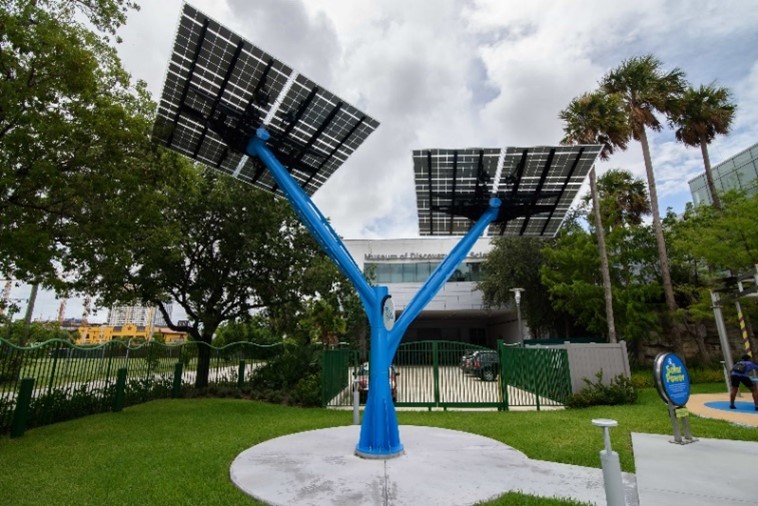By Andrea Hart, Museum of Discovery and Science
The Museum of Discovery and Science (MODS) in downtown Fort Lauderdale has embarked on an exciting journey to transform public understanding of solar energy. In collaboration with our major partner, Florida Power & Light (FPL), the museum aims to advance public understanding of solar energy and its critical role in creating a sustainable future through the FPL SolarNow Program.

Central to this initiative is the FPL Solar Tree in MODS’ Science Park. This tree-shaped structure, covered in solar panels, powers the museum while serving as an interactive educational tool. Guests encounter ”Sunny,” an augmented reality avatar guiding them through solar energy basics and the FPL SolarNow Program. This engaging experience helps guests understand how sunlight becomes clean, renewable electricity.
A second solar exhibit in the FPL Storm Center gallery allows guests to simulate solar energy distribution across a community. This hands-on experience demonstrates how solar panels can sustain homes, schools and businesses, even without constant sunlight, emphasizing solar technology’s practicality and importance in advancing sustainable practices.
Florida averages 230 days of sunshine annually, making it an optimal location for solar energy. MODS and FPL also installed a 25-kilowatt solar array above the Esplanade Balcony.
The MODS STEMobile’s solar power program empowers the community to explore how the sun’s energy can be transformed into usable electricity. Through hands-on activities, participants delve into various solar technologies, understanding energy and circuits while tackling an engaging engineering challenge.
This program is part of MODS’ broader mission to advance STEM education and environmental awareness, fostering a deep connection between students and the natural world and nurturing future environmental stewards. Launched in 2021, STEMobile travels across South Florida, bringing high-quality, age-appropriate environmental education to diverse communities.
As guests explore these exhibits, they’re encouraged to consider their role as advocates and innovators in the solar energy movement, as well as their potential to join the growing solar energy job market, which now surpasses traditional industries like oil drilling and coal mining. Guests learn about career opportunities in the field, from engineering and maintenance to business leadership and policymaking, projected to reach 538,000 careers in the U.S. by 2032.
Florida’s position as a leader in solar energy is showcased in these exhibits through information about one of the largest solar-powered battery installations in the United States at the Manatee Energy Storage Center. This facility, with more than 340,000 solar panels on a 751-acre site, can generate 409 megawatts (MW) and 900 megawatt hours (MWh). Its capacity to power approximately 329,000 homes for more than two hours demonstrates the significant impact and potential of solar energy in the state’s energy landscape.
MODS’ commitment to sustainability extends beyond exhibits. By integrating solar technology into its facility operations, the museum reduces its energy consumption while motivating the community to embrace solar power.
This collaboration with FPL SolarNow exemplifies how institutions can work together to promote renewable energy and environmental awareness.

Through engaging, hands-on exhibit experiences that make solar energy accessible and understandable, MODS and FPL SolarNow are encouraging our community to think critically about energy usage, paving the way for a future where clean, renewable energy is not just a possibility, but a reality.
While at the museum, guests can watch the IMAX documentary film ”Cities of the Future,” presented by MacGillivray Freeman Films and the American Society of Civil Engineers. This film unveils groundbreaking innovations shaping our world, inviting guests to step into the future and discover the exciting innovations engineers are working on right now to meet the challenges of a changing world and transform the way we live.
Renewable energy will be our primary power source, with solar energy beamed down from space powering entire cities. Smart buildings will keep us cool, and we will travel on aerial highways in individualized pods that run on little or no energy. Electric air taxis will make traffic jams a thing of the past. This isn’t science fiction — this is the world engineers are designing right now.
As climate change challenges mount, significant initiatives and partnerships such as this will continue to play a crucial role in informing and inspiring the public to embrace sustainable solutions.
Andrea Hart is the vice president of exhibits at the Museum of Discovery and Science with a master’s in museum studies from the Harvard University Extension School and more than 15 years of experience developing exhibitions throughout Florida.
Sign up for The Invading Sea newsletter by visiting here. If you are interested in submitting an opinion piece to The Invading Sea, email Editor Nathan Crabbe at ncrabbe@fau.edu.



